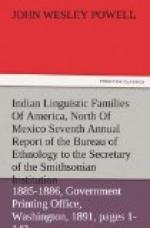< Shasta, Bancroft, Nat. Races, III,
565, 1882 (contains Palaik of
present family).
Derivation: From the Klamath word p’laikni, signifying “mountaineers” or “uplanders” (Gatschet).
In two places[73] Hale uses the terms Palaihnih and Palaiks interchangeably, but inasmuch as on page 569, in his formal table of linguistic families and languages, he calls the family Palaihnih, this is given preference over the shorter form of the name.
[Footnote 73: U.S. Expl. Expd., 1846, vol. 6, pp. 199, 218.]
Though here classed as a distinct family, the status of the Pit River dialects can not be considered to be finally settled. Powers speaks of the language as “hopelessly consonantal, harsh, and sesquipedalian,” * * * “utterly unlike the sweet and simple languages of the Sacramento.” He adds that the personal pronouns show it to be a true Digger Indian tongue. Recent investigations by Mr. Gatschet lead him, however, to believe that ultimately it will be found to be linguistically related to the Sastean languages.
GEOGRAPHIC DISTRIBUTION.
The family was located by Hale to the southeast of the Lutuami (Klamath). They chiefly occupied the area drained by the Pit River in extreme northeastern California. Some of the tribe were removed to Round Valley Reservation, California.
PRINCIPAL TRIBES.
Powers, who has made a special study of the tribe, recognizes the following principal tribal divisions:[74]
Achoma’wi.
Atua’mih.
Chuma’wa.
Estake’wach.
Hante’wa.
Huma’whi.
Ilma’wi.
Pakamalli?
[Footnote 74: Cont. N.A. Eth. vol. 3, p. 267.]
PIMAN FAMILY.
= Pima, Latham, Nat. Hist. Man, 898, 1850 (cites three languages from the Mithridates, viz, Pima proper, Opata, Eudeve). Turner in Pac. R. R. Rep., III, pt. 3, 55, 1856 (Pima proper). Latham in Trans. Philolog. Soc. Lond., 92, 1856 (contains Pima proper, Opata, Eudeve, Papagos). Latham, Opuscula, 356, 1860. Latham, El. Comp. Phil., 427, 1862 (includes Pima proper, Opata, Eudeve, Papago, Ibequi, Hiaqui, Tubar, Tarahumara, Cora). Gatschet in Mag. Am. Hist., 156, 1877 (includes Pima, Nevome, Papago). Gatschet in Beach, Ind. Misc., 429, 1877 (defines area and gives habitat).
Latham used the term Pima in 1850, citing under it three dialects or languages. Subsequently, in 1856, he used the same term for one of the five divisions into which he separates the languages of Sonora and Sinaloa.
The same year Turner gave a brief account of Pima as a distinct language, his remarks applying mainly to Pima proper of the Gila River, Arizona. This tribe had been visited by Emory and Johnston and also described by Bartlett. Turner refers to a short vocabulary in the Mithridates, another of Dr. Coulter’s in Royal Geological Society Journal, vol. XI, 1841, and a third by Parry in Schoolcraft, Indian Tribes, vol. III, 1853. The short vocabulary he himself published was collected by Lieut. Whipple.




